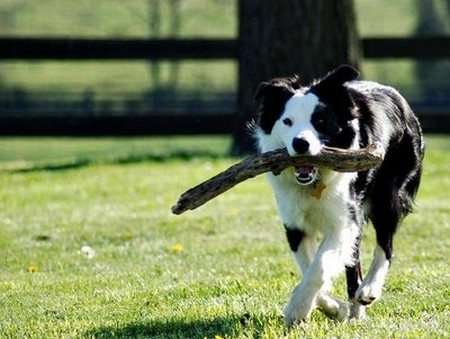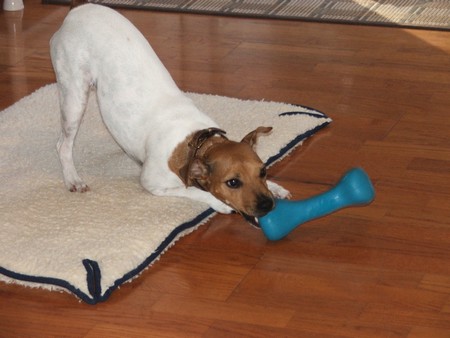Fetching is a natural thing for most dogs to do, especially those that were bred specifically for this purpose. The retrieval breeds are the Labrador, the golden retriever and the curly-coated retriever, to name only a few. These types of dogs will pick up anything in their mouths and carry it around without too much persistence on your part, but it will take a little longer for you to teach them to come and sit in front of you and hold the object until you remove it from their mouths.
There are several breeds that are not natural retrievers: the Doberman, the German shepherd, the Rottweiler, the collie, and some of the smaller lapdog types, again to name only a few. However, all dogs can be trained to fetch and carry something—but doing so must be fun for them. Smaller dogs like chihuahuas may also find it hard to play fetch when it’s too cold outside, see their reaction to the cold and decide if they need a chihuahua winter coat to stay warm.
Teaching a natural fetcher
If your dog is a natural retriever but lacks the finishing touches required for entering a competition, or if you just want more control over it, then follow the instructions in this article to get your dog to fetch an object, deliver the object to you and hold it in its mouth until you command: “Give!”
What normally happens with dogs is, as soon as you try to introduce anything remotely regimental, they lose interest. So what you will have to do initially is to separate the two actions of retrieving and holding the object. Play the “throw the object” game, allowing your dog to chase an object and bring it to you and maybe even drop it at your feet. The aim of the game is to get the dog to deliver to you an object it has fetched.
Then teach your dog to hold the object. Start off with a soft item that will not hurt its mouth, such as a rolled-up piece of vinyl or a length of rolled to welling. Ensure that the object is not too large—it should fit into the dog’s mouth with ease.
Place your dog oh-lead, and stand on the lead so that it cannot run away. Gently open its mouth, and say “Hold.” We use the command “Hold” here because, once you put the two exercises—fetching and holding—together, you will be able to ask your dog to keep holding the object rather than dropping it once it has retrieved it for you.
Place the object in the dog’s mouth, just behind its fangs, and tilt its head back slightly so that it cannot spit the object out. Reprimand with your one-word reprimand word at the precise moment your dog tries to eject the object, and praise as soon as it stops trying to do so.
Initially, just getting your dog to hold the object while you are tilting its head back is sufficient. Leave the object in for only five seconds, making a big fuss of your dog as soon as you take the object gently out of its mouth.
Once you have your dog holding an object successfully and happily, go back to throwing the object, asking the dog to “Hold” as it comes closer to you, and praising as it does so.
Use only a very soft tone when reprimanding in this exercise—you want your dog to enjoy it.
Eventually, the fetching and holding actions will become a single exercise for your dog, and you will be able to phase out the “Hold” command. Then, to get your dog to adopt the “sit” position with the object in its mouth, just pat it gently, and, as you are doing so, press gently down on its rump until it sits. With both patience and practice, the command “Fetch” will eventually cause your dog to run out and grab an object, bring it back to you, and then sit in front of you and hold the object until you command “Give.”
Even though your dog may already be happy to carry sticks and other large objects for you, you will need to follow these guidelines when training it to fetch for you. DeListProduct has tons of great dog supplies that could help you out with training your dog.
Remember that the purpose of this exercise is to harness your dog’s chasing and fetching action so that you will be able to predict what it will do. Otherwise it will fetch objects only when it feels like it, and will not be a reliable retriever.
Remember, too, that you still want your dog to have fun chasing objects that you throw for it, and training it to “fetch” means teaching it a regimented exercise that, to the dog’s way of thinking, will not be fun at first.
So, the more pleasant you can make the process, the faster the dog will accept it.
Teaching a dog that runs away with the object
If your dog is the type that runs to get the object thrown, and then runs away with it, you will need to use the one-word reprimand. If it then responds by coming to you, praise it. If it drops the object, throw it again.
If the dog still keeps running away, do not chase it. Instead, select an area where your dog has to come to you and cannot avoid you—such an area should have only one way out, and should preferably be narrow. For example, you may choose a passageway or an area at the side of your house that is blocked off by a fence.
Once your dog is unable to run away from you because of the confined area in which you are training it, it will have to run to you. As it attempts to run past you, block its path, and then praise it lavishly, acting as if it has done the most wonderful thing imaginable.
The first time you do the training, repeat this process several times. Then do the same thing each evening for the next few days. This will lead the dog to realize that the reward is better when it brings the object to you than when it escapes. (You could also try giving your dog a treat, when it gives you the object despite its obvious reluctance to relinquish its find!)
The benefits of getting your dog to fetch things for you do not need to be explained—and you will find it even more useful to have a dog that is willing to give up what it has fetched without a struggle!

